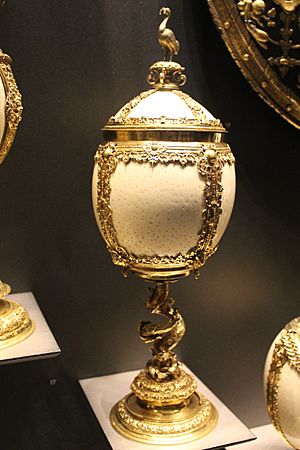Andrew Melville of Garvock facts for kids
Andrew Melville of Garvock (died 1617) was an important Scottish courtier. He worked for Mary, Queen of Scots and later for her son, James VI of Scotland.
Contents
About Andrew's Family
Andrew Melville was born into a well-known Scottish family. His father was John Melville of Raith from Raith in Fife. His mother was Helen Napier.
Andrew had an older brother, James Melville of Halhill, who wrote a famous book about politics. Another brother, Robert Melville, was a skilled politician. Andrew was also the uncle of the poet Elizabeth Melville.
The family's estate, Garvock, was near Dunfermline. The old house there was taken down many years ago.
Working for Mary, Queen of Scots
Andrew Melville started his career serving Mary, Queen of Scots. He was sent to her when she was held at Lochleven Castle. He brought her jewels and other items from her home. Later, he brought her three gowns at Carlisle Castle in England.
Andrew then joined Mary's household in England. He became the main manager of her home, known as the Master of Household. He took over this role from Andrew Beaton.
Mary's Household and Security
In 1581, Mary asked for horses for her riders. She was allowed four horses for her men to ride with her coach. These riders included Melville, Claude Nau, Gilbert Curll, and Bastian Pagez. In 1585, Andrew received silver dishes for Mary from Queen Elizabeth's royal collection.
Melville was a witness at the wedding of Mary's secretary, Gilbert Curll, in 1585. Mary's keeper, Amias Paulet, thought Melville did not like the French secretary Claude Nau. Paulet wanted Melville and some other servants removed from Mary's household for security reasons.
Mary's Execution and Aftermath
Melville was suspected of being involved in plots in 1586. His family in Scotland were happy when he was found innocent. He was brought back to Mary's household at Fotheringhay Castle in October 1586.
William Cecil asked Melville and other ladies to sign papers for Mary's execution. At Fotheringhay, Mary spoke to Melville just before her execution. She gave him messages for her son, James VI of Scotland. Another story says Melville was very sad and knelt before Mary. Mary told him to be brave and said goodbye with a kiss.

After Mary's execution, Andrew Melville, his wife Jean Kennedy, and Mary's doctor were put in charge of Mary's remaining jewels and silver. Melville was also in charge of the embroidery for a bed Mary had made. These pieces are now called the "Oxburgh Hangings". Mary had asked Andrew to take the bed hangings and other items, like portraits and a piece of unicorn horn, back to Scotland for her son James VI.
While still at Fotheringhay, Melville wrote a note to help settle the affairs of some servants. Some servants were owed money. Others needed their belongings returned. Amias Paulet sent Melville's note to William Cecil, and the requests were granted.
Melville was allowed to choose who would attend Mary's funeral at Peterborough Cathedral. Only Melville attended the final service. It was a tradition for household officers to break their staffs of office over their head and put them in the grave. Melville may have done this.
Melville was held in England for a while. His brother James wrote to him in 1587, saying their mother wanted to see him. James VI asked his ambassador to help free Melville. However, Melville had already been released.
Serving James VI in Scotland
Andrew returned to Scotland. In 1589, his wife, Jean Kennedy, drowned in a ferry accident on the Forth. The accident was blamed on a storm or bad sailing.
Andrew Melville continued to serve as a Master of the Royal Household for King James VI. He received money for clothes to attend the coronation of Queen Anne of Denmark in 1590. Guests at the coronation were asked to bring gifts of food, like beef and venison, to Andrew Melville at the old royal mint in Edinburgh.
Melville received a regular payment from the lands of Crossraguel Abbey. In 1590, he made a list of silver items used in the king and queen's household. This list included two silver ships, called nefs, and an ostrich egg cup.
In 1591, Melville helped King James when he was surprised by Francis Stewart, Earl of Bothwell at Holyrood Palace. Melville had a house nearby. He armed himself and entered the palace through a secret passage from the Abbey.
In 1594, Andrew and his brothers hosted ambassadors from Denmark and Germany. They were visiting for the baptism of Prince Henry, the king's son.
Melville kept in touch with Bess of Hardwick, who had been one of Mary's keepers. In 1607, he shared news about the trial of a servant accused of stealing Queen Anne's jewels. In 1608, he wrote about an earthquake felt at Garvock. That same year, he hosted a German duke visiting Scotland.
Andrew Melville died on April 13, 1617.
It is thought that Andrew Melville saved a manuscript of the Scottish history of Mary's time. This history was written by John Lesley, who was a bishop.
Family Life and Children
Andrew Melville's first wife was Jane Kennedy. She drowned in the Forth ferry accident in 1589.
He then married Elizabeth Hamilton. King James VI gave a ring to Elizabeth at the christening of their first child in 1594.
His children with Elizabeth Hamilton included:
- Janet Melville (born 1600)
- Andrew Melville (born 1603)
- John Melville (born 1604)
- Anna Melville, who married Sir James Murray of Tippermuir in 1624. He was known for collecting poems.
- George Melville, who married the widow of a king's servant named David Drummond.
- Elizabeth Melville
- Helen Melville
|

